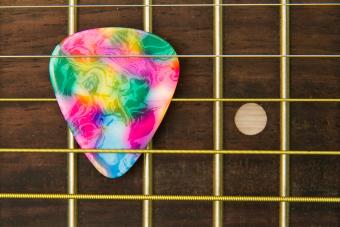
There are a number of reasons to learn the notes on the guitar. If your goals include reading, composing, arranging, or playing with other skilled musicians or singers, knowing the language of music is extremely important. Once you gain an intimate knowledge of your instrument and the notes as they appear on it, your musicianship will grow by leaps and bounds.
Printable Examples
The four examples in this printable will serve as the basis for this lesson. To print, click on the image. If you need help, consult this Guide To Adobe Printables.

The open strings of the guitar in standard tuning from low to high are E-A-D-G-B-E. Example one shows every note on the guitar on the first twelve frets. On alternate strings, the accidentals are called either sharps or flats to illustrate the enharmonic equivalents, which are the sharps and flats that are the same note. For example A# = Bb, C# = Db, D# = Eb, F# = Gb and G# = Ab. There are no sharps or flats between B and C or E and F.
Practice Ideas for Example One
Practicing the first example can help you learn the notes.
- This example contains a lot of information. "Chunk it down" and start by focusing on the notes on the first three frets. Then, move up the neck three frets at a time.
- Do a "say it and play it." Pick a single string and play all 12 notes on that string slowly as you say the letter name of each note out loud. Repeat this exercise with all other strings.
- The notes on each string repeat after twelve frets. Figure out the notes on the 13th fret and above for each string.
- Study the layout of the notes on the guitar. Visualize the fret board and work on seeing the notes while you are away from the guitar.
Practice Ideas for Example Two

In example two, the notes on the entire guitar are broken down to a one octave scale in the first position. This illustrates the point "everything is everywhere" on the guitar. In other words, any phrase, lick, riff, melody, or chord can be played anywhere on the guitar since the 12 notes of the chromatic scale exist everywhere and in every position on the fret board.
- Play the notes in the scale as they appear in example two slow, medium, and fast. Pick and articulate them cleanly.
- Play the same scale from every other "E" note up the fret board you can find in example one.
- Play anything you already know in as many positions and from as many starting points as you can.
- The notes in the C major chord are C, E and G. See how many ways you can play those three notes together, in any combination or order in the first position.
Practice Ideas for Examples Three and Four
Example three depicts the C major scale, C-D-E-F-G-A-B-C, in two octaves. Example four shows the C major arpeggio, C-E-G, in two octaves. Scales and arpeggios, whether they are major, minor, or otherwise, are the basis for melodies. Practicing and learning musical constructs like scales and arpeggios has many benefits in addition to learning the notes, including improving technique and accuracy, improving your ear, and helping you gain fluidity in your playing.
- Play the scale/arpeggio up and down using alternate (up/down) picking. Experiment with different fingerings until you find one you like best.
- Find another starting point, such as F or B-flat, and play the same major scale/major arpeggio. Notice how they fall on the guitar differently in other keys.
- Play these major scales and arpeggios in all 12 keys in the following order: C - F - B-flat - E-flat - A-flat - D-flat - G-flat - B - E - A - D - G.
- Simple songs like Jingle Bells, Ode To Joy, Happy Birthday, Let It Be, and many others come from the major scale and/or arpeggio. Pick out and figure out these melodies by ear and see and hear how the notes relate to each other on the fingerboard as you do. Sing along.
Moving Forward
Learning guitar notes is a very big topic, and the exercises above serve as a starting point to get you thinking about, seeing, and hearing the guitar in a new and exciting way. Learning guitar chord progressions is another excellent step for beginners. If you don't already, start to learn how to read standard music notation. Reading music will enable you to learn more music faster and bring many of theses ideas together.







